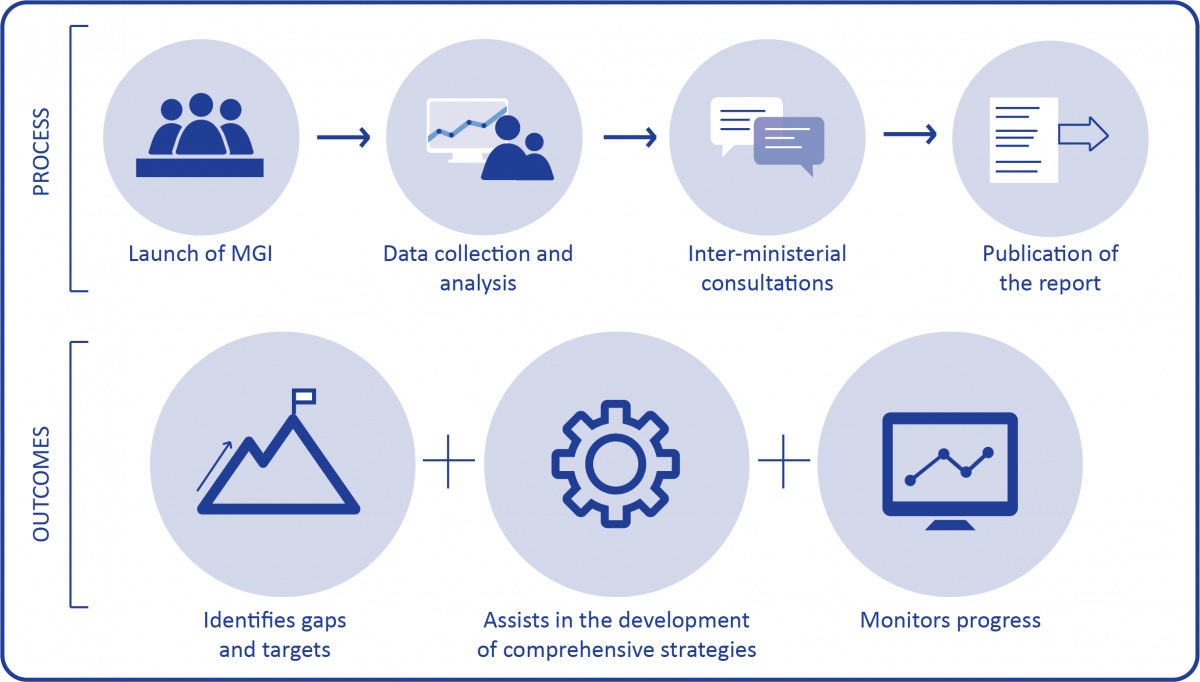-
Who We Are
WHO WE AREEstablished in September 2015, the International Organization for Migration’s Global Migration Data Analysis Centre was set up to respond to calls for better international migration data and analysis. Data are key to inform migration governance, improve programming and promote a better public understanding of migration.
About
About
IOM Global
IOM Global
-
Our Work
Our WorkData is key to inform migration governance, improve programming and promote a better public understanding of migration. GMDAC works toward this purpose through activities in knowledge management, data capacity-building and innovation, and data collection and analysis.
Areas of Work
Areas of Work
Projects
Projects
- Data and Resources
- Take Action
In 2015, IOM developed a Migration Governance Framework (MiGOF) to help define what “well-managed migration policy” might look like at the national level. The MiGOF was welcomed by IOM’s Member States the same year. The Migration Governance Indicators (MGI) were developed to assess national frameworks, and help to operationalize the MiGOF.
The MGI is a tool based on policy inputs, which offers insights on policy levers that countries can use to develop their migration governance. The MGI is not meant to rank countries on the design or implementation of migration policies, but rather to be a framework to help countries in the assessment of the comprehensiveness of their migration policies, as well as to identify gaps and areas that could be strengthened. The MGI aims to advance conversations on migration governance by clarifying what “well-governed migration” might look like in the context of SDG Target 10.7.
The six dimensions of migration governance included in the MiGOF and MGI are:
- Migrants' Rights
-
Indicators in this domain assess the extent to which migrants have the same status as citizens in terms of access to basic social services such as health, education, and social security. It also describes the rights of migrants to family reunification, to work, and to residency and citizenship. The ratification of the main international conventions is also included within this domain.
- Whole of Government Approach
-
Indicators in this domain assess countries’ institutional, legal, and regulatory frameworks related to migration policies. Domain 2 also reviews the existence of national migration strategies that are in-line with development, as well as institutional transparency and coherence in relation to migration management. This domain also investigates the extent to which governments collect and use migration data.
- Partnerships
-
This domain focuses on countries’ efforts to cooperate on migration-related issues with other states and with relevant non-governmental actors, including civil society organizations and the private sector. Cooperation can lead to improvements in governance by aligning and raising standards, increasing dialogue and providing structures to overcome challenges.
- Well-Being of Migrants
-
This domain includes indicators on countries’ policies for managing the socioeconomic well-being of migrants, through aspects such as the recognition of migrants’ educational and professional qualifications, provisions regulating student migration and the existence of bilateral labour agreements between countries. Indicators equally focus on policies and strategies related to diaspora engagement and migrant remittances.
- Mobility Dimensions of Crises
-
This domain studies the type and level of preparedness of countries when they are faced with mobility dimensions of crises, linked to either disasters, the environment and/or conflict. The questions are used to identify the processes in place for nationals and non-nationals both during and after disasters, including whether humanitarian assistance is equally available to migrants as it is to citizens.
- Safe, Orderly and Dignified Migration
-
This domain analyses countries’ approach to migration management in terms of border control and enforcement policies, admission criteria for migrants, preparedness and resilience in the case of significant and unexpected migration flows, as well as the fight against trafficking in human beings and smuggling of migrants. It also assesses efforts and incentives to help integrate returning citizens.
There are four phases for the MGI process:
- Launch of the MGI process: The first step of the process is to organize a briefing for government officials to explain what the MGI entails, and to ensure their complete buy-in.
- Data collection and analysis: The second step of the process is to start the collection and analysis of data, based on ninety indicators grounded in the six dimensions of the Migration Governance Framework (i.e., migrants’ rights, whole of government approach, well-being of migrants, partnerships, mobility dimension of crises, and safe, orderly and regular migration). A draft Migration Governance Snapshot based on the findings on analysis is then shared with the government counterparts.
- Inter-ministerial consultation: The third step of the process is to convene an inter ministerial consultation where all relevant ministries and other stakeholders discuss the good practices and main gaps identified in the draft Migration Governance Snapshot. It is also an opportunity for them to comment and provide suggestion on the draft snapshot.
- Publication of the report in the Global Migration Data Portal: After the Migration Governance Snapshots are finalized and vetted by the government counterparts, they are published on the IOM’s Global Migration Data Portal.
- Process Infographic
-

The MGI country snapshots are available on the Migration Data Portal.
